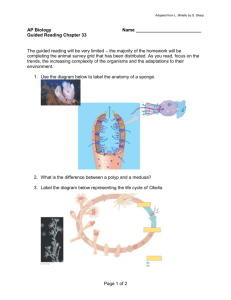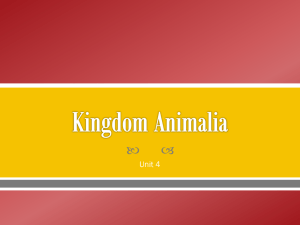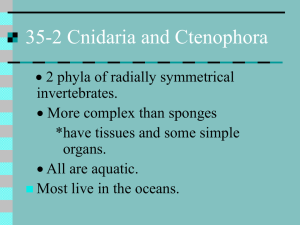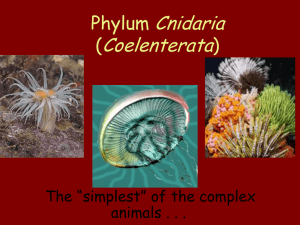Porifera and Cnidarians PowerPoint
advertisement
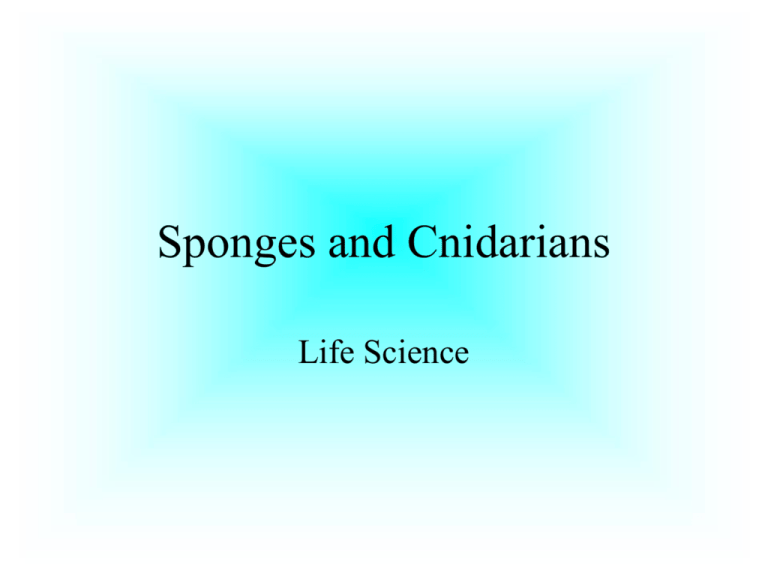
Sponges and Cnidarians Life Science Review the Animal Kingdom • 4 Major Characteristics? • Multicellular • Eukaryotic • Heterotrophs • Cells lack cell walls 7 Essential Functions? • Feeding • Response • Respiration • Movement • Circulation • Reproduction • Excretion Hard Shells Phylum Porifera “Pore-Bearers” Sponges are the simplest of all animals. They are multicellular, heterotrophic, have no cell walls, and have specialized cells. Sheet sponge Carnivorous- eat small crustaceans Adult sponges are sessile. CAN”T MOVE They live attached to a single spot. Sponges are asymmetrical filter feeders Feed on : bacteria, unicellular algae, and protists through filter feeding. IV. Phylum- Porifera (“pore bear”) – sponges – simplest of all animals A. Body Plan – asymmetrical, pores all over body with large hole on top called osculum where water is pumped through, Have no mouth or gut, Have no tissues or organ systems, Simple functions are carried out by a few specialized cells B. Protection: skeleton of spicules (glass-like material) or spongin (soft) Asymmetrical? Have no front or back ends, no left and right sides – A large, cylindrical water pump – The body forms a wall around a large central cavity through which water flows continually Protection- Silica (cells of glass offer protection and support C. Feeding – filter feeders, trap microorganisms in water flow. 1. Collar cells - specialized cells that use flagella to move a steady current of water thru the sponge. Each collar cell digests its own food. 2. Archaeocytes specialized cells that make spicules 3. Pore cells – Cells thru which water flows into the body of a sponge Major Body Functions D. Respiration/ Circulation/ Excretion – water flow carries out all body functions (osmosis and diffusion) • As water moves through the cavity: 1. Oxygen dissolved in the water diffuses into the surrounding cells 2. Carbon dioxide and other wastes, diffuse into the water and are carried away Major Body Functions E. Response/Movement- no nervous system, do produce toxins, adults don’t move (sessile), larva swim F. Reproduction- sexually with internal fertilization between two different sponges or asexually by budding or fragmentation Osculum A large hole at the top of the sponge, through which water exits The movement of water provides a simple mechanism for feeding, respiration, circulation and excretion The Anatomy of a Sponge Water flow Osculum Central cavity Pores Collar Cell Spicule Pore cell Pore Epidermal cell Archaeocyte Ecology of Sponges 1. Ideal habitats for marine animals such as snails, sea stars, sea cucumbers, and shrimp 2. Mutually beneficial relationships with bacteria, algae and plant-like protists Sponge Life Cycle (Sexual Reproduction) Sponges are hermaphrodites. MEIOSIS Adult sponge releases sperm into the water Haploid (N) Diploid (2N) New sponge Sperm (N) Mature sponge (2N) Egg (N) Larva attaches to a hard surface The zygote develops into a free swimming larva Larva (2N) FERTILIZATION Sperm fertilize eggs inside the body of another sponge Review Questions Answer the 4 questions on your own. Asexual Reproduction-Budding A new polyp genetically identical to the parent is formed. Jelly fish Lion’s Mane Jelly Some have eyes! Box Jelly Colony of polyps Deadly within 3 minutes! Over 100 deaths in the last 25 years Found off the coast of Australia Chironex fleckeri Anemones Colonial Anemone Coral Reefs Brain Coral Orange Cup Coral Red Sea Fan Sea Pen Feathery Hydroid Fungiid Coral- this coral can move! Carpet Anemone Giant Sea Fan Mushroom Coral Solid Table Coral Staghorn Coral Phylum Cnidaria –more complex than sponges A. Carnivorous animals with stinging tentacles around their mouths B. Simplest animals to exhibit symmetry – cnidarians have radial symmetry C. Simplest animals to have true tissues including nerves Cnidarians have two body forms Polyp - stationary, vase-shaped Medusa - swimming, cup-shaped Examples: hydra, coral, sea anemone Examples: jellyfish, portuguese man of war Examples: hydras, jellyfishes, sea anemones, and corals A. Hydrozoans: Most of life as polyp ex. hydra B. Scyphozoans: Most of life as medusa ex. jellyfish C. Anthozoans: Only polyp stage in the life cycle ex. corals and sea anemones Simplest animal with true tissues. – soft bodied, have tentacles, radial symmetry, 1. Gut – gastrovascular cavity with one opening 2. Nerve net- detects stimuli 3. Hydrostatic Skeleton- movement and support with the use of muscles The Polyp and Medusa Stages 1. Polyp - Stationary, Examples: Hydra, Coral, and Sea Anemone 2. Medusa- Swimming, Cup Shaped. Examples: Jelly Fish and Man O War The Polyp and Medusa Stages 3 tissue layers Epidermis Mesoglea Gastroderm Tentacles Bell gut Mouth/anus Mouth/anus Gut Tentacles Medusa Polyp 1. Feeding- kill small prey with stinging cells in tentacles, digest in gut, food in and waste out of one opening. 2. Respiration/Circulation/Excretion- all by diffusion (no true organs) 3. Response- have specialized sensory cells and nerve net to gather info and react to stimuli. Response a. Statocysts: groups of sensory cells that help determine the direction of gravity b. Ocelli: eyespots made of cells that detect light (Stinging Structure) (Stinging Cell) 4. Movement- propel themselves with water using hydrostatic skeleton 5. Reproduction- asexually by budding, sexually by external fertilization, sperm and egg are released and meet in water IX. Ecology of Cnidarians A. Source of new drugs/chemicals sunscreen 855 B. Provide habitats for marine organisms C. Source of food for other organisms (like sea turtles) D. Symbiotic relationships with other organisms Jellyfish Life Cycle (Sexual Reproduction) Female medusa (2N) MEIOSIS Egg (N) FERTILIZATION Adult medusas reproduce sexually by releasing gametes into the water. Sperm (N) Zygote (2N) Male medusa (2N) Young medusa Each zygote grows into a ciliated larva. The larva eventually attaches to a hard surface and develops into a polyp. Swimming larva Polyp The polyp buds to release young medusas. Haploid Diploid Fertilization occurs in the open water, producing many diploid zygotes. Budding polyp Answer the 2 review questions

